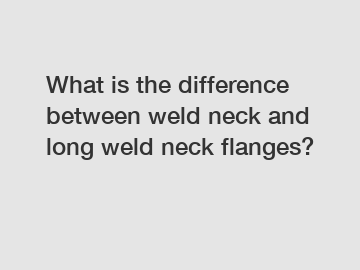What is the difference between weld neck and long weld neck flanges?
What is the difference between weld neck and long weld neck flanges?
If you are in the field of piping, you may have come across the terms "weld neck" and "long weld neck" flanges. These flanges play a crucial role in joining pipes and equipment, ensuring a leak-tight connection. But what sets them apart? In this article, we will explore the key differences between weld neck and long weld neck flanges, from their physical characteristics to their applications and advantages.
1. Physical Characteristics:

- Weld Neck Flanges: These flanges have a tapered neck that extends from the flange's base. They are designed to be butt-welded to the pipe, ensuring a tight and strong connection. Weld neck flanges also have a raised face, providing additional support and stability.
- Long Weld Neck Flanges: As the name suggests, long weld neck flanges have a longer neck compared to standard weld neck flanges. The extended neck allows for easier access to the flange during maintenance and inspection activities. Like their shorter counterparts, long weld neck flanges also have a raised face for increased stability.
2. Applications:
- Weld Neck Flanges: These flanges are commonly used in high-pressure and high-temperature applications. Their design provides excellent rigidity and strength, making them suitable for critical piping systems, such as oil refineries, chemical plants, and power generation facilities.
- Long Weld Neck Flanges: Due to their extended neck, these flanges find applications in situations where additional clearance is required. They are often employed in tanks, vessels, and equipment connections, allowing for convenient access and attachment points.
3. Advantages:
- Weld Neck Flanges: The tapered neck of weld neck flanges eases the stress concentration at the base, making them resistant to deformation under high pressures. They provide a reliable and leak-free connection, minimizing the risk of leaks in critical applications.
- Long Weld Neck Flanges: Alongside the benefits offered by standard weld neck flanges, the extended neck of a long weld neck flange has numerous advantages. It allows for easy welding, inspection, and maintenance, reducing downtime in industrial operations. Additionally, the longer neck helps to minimize thermal stresses induced by welding or environmental factors.
4. Selection Considerations:
- Weld Neck Flanges: When selecting weld neck flanges, factors like pipe size, pressure rating, material compatibility, and design standards should be considered. Correctly matching the flange specifications to the application requirements ensures optimal performance and safety.
- Long Weld Neck Flanges: The decision to use long weld neck flanges depends on the specific needs of the installation and future maintenance requirements. Considerations like accessibility, clearance, and potential expansion or contraction of the connected equipment should be carefully evaluated.
In conclusion, weld neck and long weld neck flanges serve different purposes in the piping industry. While weld neck flanges are commonly used for high-pressure and high-temperature applications, long weld neck flanges provide additional clearance and accessibility. Both types offer robust connections and leak-tight seals when appropriately selected and installed. Understanding the differences between these flanges allows engineers and industry professionals to make informed decisions based on their specific requirements. So, whether you are designing a critical refinery piping system or connecting equipment in a tank, choose wisely between weld neck and long weld neck flanges for a secure and reliable connection.
If you want to learn more, please visit our website OCTG Pipes, Alloy Steel Flange, OCTG Casing.

Comments
0